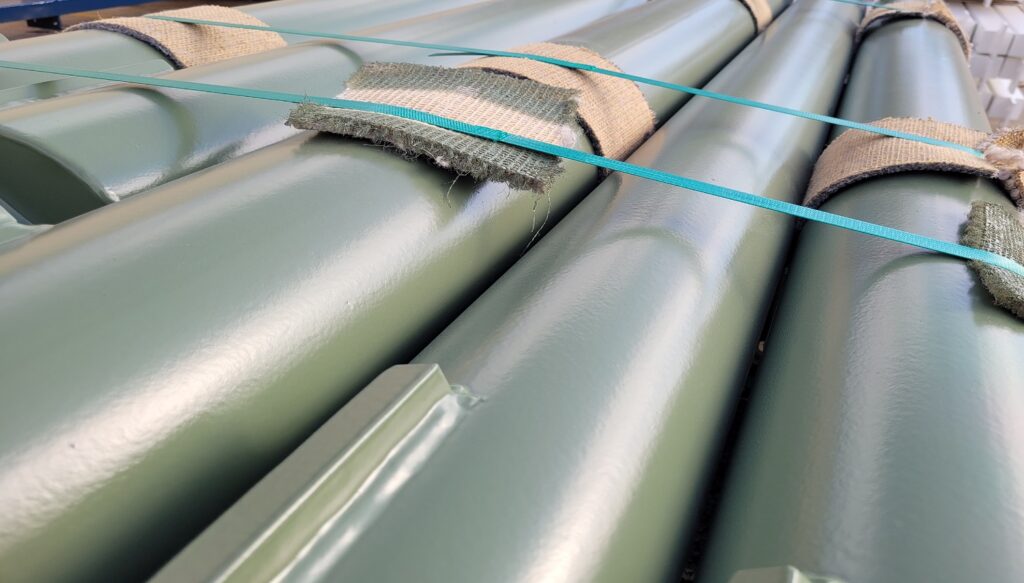
Common Paint System Thickness
This article gives an overview of the thickness of industrial paints used in Australia, and when they are usually specified. Note that all advice is general in nature, and you should consult an expert before making a decision.

Common paint system thicknesses depend entirely on the type of coating system required. There are many specifications, each for a different environment, which will require a certain thickness of paint. The information below is a general guide of the usual thickness of different types of paint. Each thickness is the dry film thickness (DFT) which is the thickness of the paint after it has dried onto the steel surface. Paint thickness is measured in microns (µm), with 1 micron being a 1000th of a millimetre. For scale, a human hair is around 50-70 microns in diameter, and a piece of paper is approximately 110 microns thick.
Epoxy Zinc coatings usually have a dry film thickness between 50-90µm, although some zinc coatings can be applied as low as 25µm or as high as 125µm. If zinc coatings are applied above their maximum thickness, mud-cracking will occur.
Inorganic Zinc paints (IZS) normally have a dry film thickness between 50-125µm; however the maximum of some inorganic zinc silicate paints is 90µm. If zinc coatings are applied above their maximum thickness, mud-cracking will occur.
Epoxy Primer dry film thickness ranges between 40-125µm. These vary a lot because if the product is over a galvanised surface, or will be overcoated, a DFT of 50µm will often suffice, as the purpose of the primer in that case is simply to improve adhesion for the topcoat. If the epoxy primer will be used as a single-coat paint system, then the DFT should be higher – around 75-100µm. Some epoxy primers are applied as a holding primer, meaning the paint will later be removed and the steel will be re-coated. Holding primers are sometimes applied as low as 20-40 microns, to assist during welding processes, however because the paint coat is so thin, if exposed to moisture the steel may rust through the primer.
Polyurethane topcoats normally have a dry film thickness between 50-100 or 75-125µm. To obtain a smooth, glossy finish, the coat of paint needs to be a reasonable thickness – around 50-75µm, however they also cannot be too thick, as this will give a rippled effect and potentially disrupt the gloss finish.
Epoxy High Build paints can have a dry film thickness of up to 500µm (half a millimetre), however this is often applied in two or more separate coats, to allow curing to take place. epoxy high builds usually have a dry film thickness between 100-250µm per coat.
Epoxy Ultra-High Build coatings can be applied as high as 800µm, depending on the product. Most ultra high builds have a dry film thickness between 200-550µm. These types of paint have a high minimum thickness, in order to give good abrasion resistance. Some UHB coatings can be applied up to a maximum of 1000µm, but only on horizontal areas. When coatings are applied in this thickness, the surface will appear slightly wrinkled or have a rippled pattern.
Fireproofing paints are applied up to 5000µm, depending on the level of fireproofing required. The coating thickness is in proportion to the steel thickness – the thicker the steel, the less fireproof coating required. When exposed to fire or extreme heat, the fire-proof coating will swell up and insulate the structural steel from the heat for a short period of time. ‘Fire-proof’ coatings are very different from ‘heat-resistant’ coatings – With fireproof coatings, after the fire is out, the coating will need to be removed and repaired – its sole purpose is to prevent the steel from heating and failing structurally. Heat resistant coatings (like the coatings on a BBQ) are designed for corrosion protection and will withstand heat, however they do not insulate the steel from the heat.
Fireproof paint coatings are usually applied in many coats, and therefore the surface becomes very wrinkled. As seen in the photo below, with each coat of fireproof paint, the ripples become more pronounced. This does not affect the fire-proof performance, however it may look unsightly if the fire-proof structural steel is at eye level. For this reason, fireproof structural steel is often cladded if it is in a open public area such as a stadium, station or function hall.

For the exact maximum and minimum thickness of each paint, you should always consult the Technical Datasheet (TDS or PDS), which can be found by searching the supplier’s website for the product name. Fireproof coating thickness must be specified by a qualified engineer.
Disclaimer: This information is only for general informational and educational purposes only and is not intended as professional advice. All information on the site is provided in good faith, however we make no representation or warranty of any kind, express or implied, regarding the accuracy, adequacy, validity, reliability, availability, or completeness of any information on the site. All information should be independently verified with an expert prior to use, as specifications, standards, procedures, and products can change at any time. Visit our privacy policy page to learn more.
